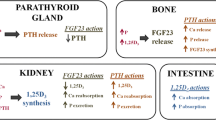Abstract
In order to clarify the complex interrelationship between serum calcium, 1,25-dihydroxyvitamin D (1,25(OH)2D), and parathyroid hormone (PTH), and the urinary excretion of cyclic AMP (cAMP) in response to exogenous PTH in pseudohypoparathyroidism (PHP) and related diseases, we investigated 3 patients with parathyroid disorders before and after treatment with 1α-hydroxyvitamin D3 (1α-OH-D3).
Low plasma 1,25(OH)2D before treatment increased after giving 1α-OH-D3 (0.1 μg/kg/day), where-as high plasma PTH measured by the C-terminal assay (C-PTH) decreased in all 3. No response in urinary cAMP was found before or after treatment in 2 patients with PHP type I, despite the fall of plasma C-PTH. However, in one patient with extremely high plasma C-PTH but normal N-PTH (measured by a homologous radioimmunoassay using 1–34 human PTH), urinary cAMP response to exogenous PTH was increased after treatment with 1α-OH-D3. We suggest that he had pseudopseudohypoparathyroidism (PPHP) with Albright's hereditary osteodystrophy and a partial deficiency of renal 1α-hydroxylase. In this patient secondary hyperparathyroidism is thought to be due to 1,25(OH)2D deficiency, and the decreased responsiveness to exogenous PTH before treatment due to excess PTH occupying renal receptors.
Similar content being viewed by others
References
Balachandar V (1975) Pseudohypoparathyroidism with normal serum calcium level. Am J Dis Child 129:1092–1095
Dokoh S (1978) Competitive protein binding assay for 1,25-dihydroxyvitamin D in human plasma. Endocrinol Jap 25:431–436
Drezner MK (1976) 1,25-dihydroxycholecalciferol deficiency: The probable cause of hypocalcemia and metabolic bone disease in pseudohypoparathyroidism. J Clin Endocrinol Metab 42:621–628
Fukase M (1979) Cholecalciferol suppression of PTH secretion from monolayer culture of human parathyroid carcinoma cells. Fourth Workshop on vitamin D, Berlin, p 61 (Abstract)
Forte LR (1976) Renal adenyl cyclose and the interrelationship between parathyroid hormone and vitamin D in the regulation of urinary phosphate and adenosine cyclic 3′,5′-monophosphate excretion. J Clin Invest 57:559–568
Fukushima M (1975) Metabolism of 1α-hydroxyvitamin D3 in perfused rat liver. Biochem Biophys Res Comm 66: 632–638
Haussler MR (1976) The assay of 1α,25-dihydroxyvitamin D3: Physiologic and pathologic modulation of circulating hormone levels. Clin Endocrinol 5:151S-165S
Honma M (1977) An ultrasensitive method for the simultaneous determination of cyclic AMP and GMP in small-volume samples from blood and tissue. Biochem Med 18:257–273
Kind HP (1973) Latent pseudohypoparathyroidism: A clue to the pathogenesis of end-organ refractoriness to parathyroid hormone. Clin Res 21:1059 (Abstract)
Kind HP (1973) A classification of the hypoparathyroid syndrome based on the PTH response test. Pediatr Res 7: 324 (Abstract)
Monn E (1976) Pseudohypoparathyroidism. A difficult diagnosis in early childhood. Acta Paediatr Scand 65:487–493
Nusynowitz ML (1976) The spectrum of the hypoparathyroid states. Medicine 55:105–119
Rodriguez HJ (1974) Pseudohypoparathyroidism type II: Restoration of normal renal responsiveness to parathyroid hormone by calcium administration. J Clin Endocrinol Metab 39:693–701
Seino Y (1978) The plasma levels of 25-hydroxyvitamin D in patients with various liver diseases and the response of 25-hydroxyvitamin D to vitamin D treatment. Acta Paediatr Scand 67:39–42
Seino Y (1980) Treatment of hypophosphatemic vitamin D resistant rickets with massive dose of 1α-hydroxyvitamin D3 during childhood. Arch Dis Child 55:49–53
Seino Y (1980) Plasma 1,25-dihydroxyvitamin D concentrations in cords, newborns, infants and children. Calcif Tiss Int 30:1–3
Seino Y Idiopathic hypoparathyroidism with Albright's hereditary osteodystrophy (in preparation)
Shimotsuji T (1976) A competitive protein binding assay for plasma 25-hydroxyvitamin D3 in normal children. Tohoku J Exp Med 118:233–240
Stögmann W (1975) Pseudohypoparathyroidism: Disappearance of the resistance to parathyroid extract during treatment with vitamin D. Am J Med 59:140–144
Werder EA (1978) Pseudohypoparathyroidism and idiopathic hypoparathyroidism: Relationship between serum calcium and parathyroid hormone levels and urinary cyclic adenosine-3′,5′-monophosphate response to parathyroid extract. J Clin Endocrinol Metab 46:872–879
Author information
Authors and Affiliations
Rights and permissions
About this article
Cite this article
Seino, Y., Ishida, M., Yamaoka, K. et al. Secondary hyperparathyroidism with 1,25-dihydroxyvitamin D deficiency and pseudohypoparathyroidism in childhood: Relationship between plasma 1,25-dihydroxyvitamin D and parathyroid hormone levels and urinary cyclic AMP response to exogenous PTH. Eur J Pediatr 135, 267–271 (1981). https://doi.org/10.1007/BF00442101
Received:
Issue Date:
DOI: https://doi.org/10.1007/BF00442101




